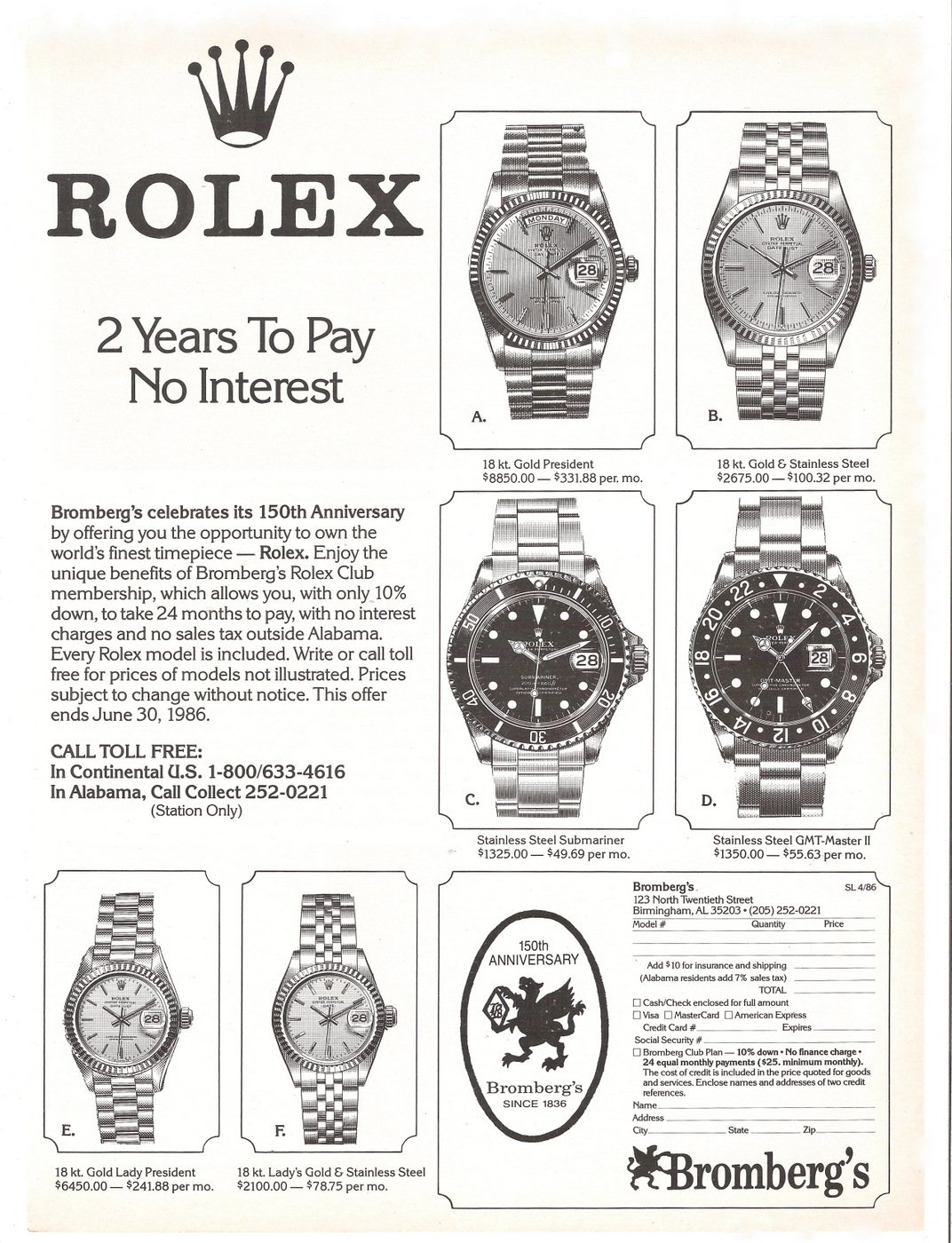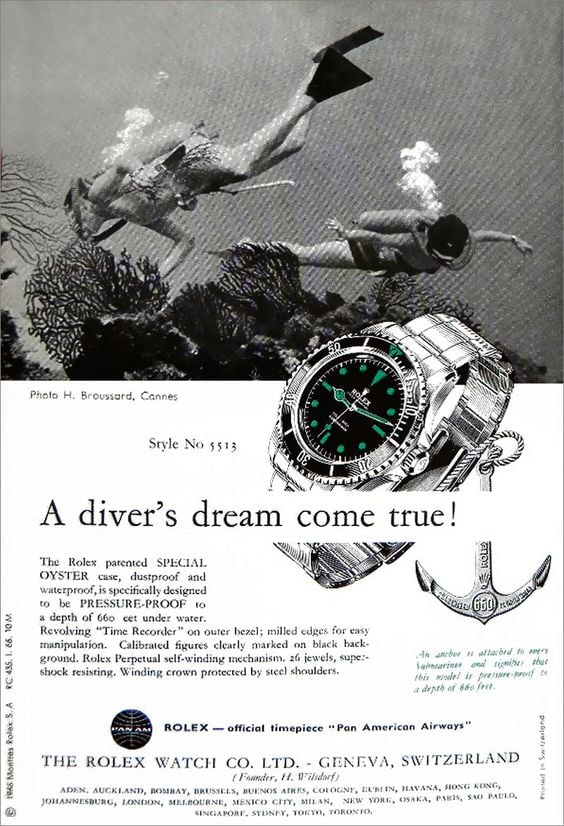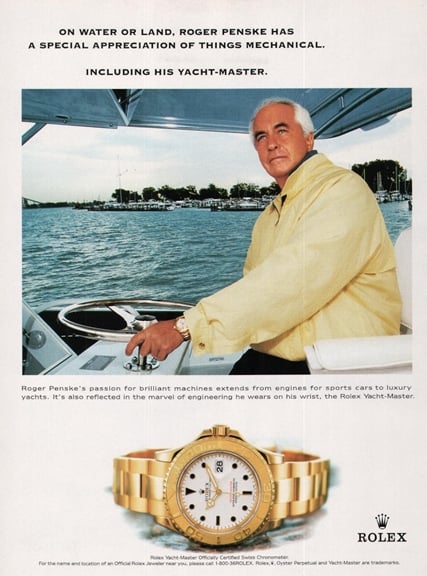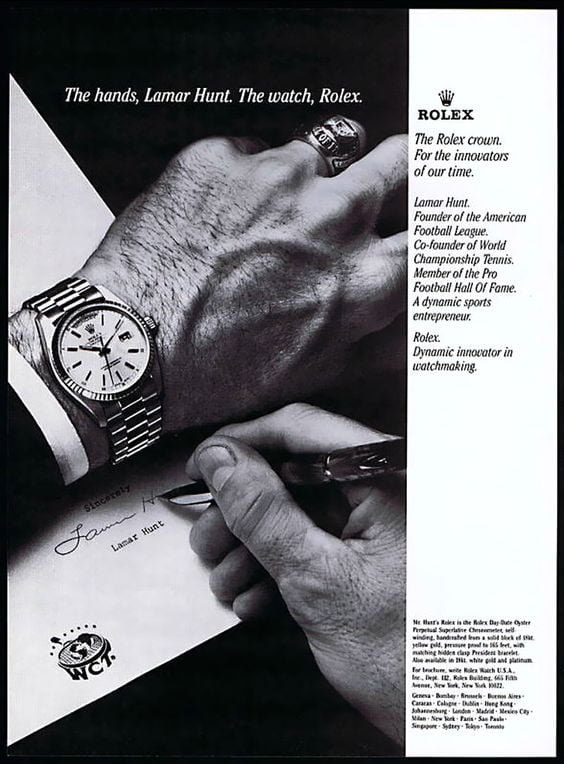5 More Remarkable Rolex Ads That Will Blow Your Mind
Rolex has a rich history of advertising built for decades. The brand has produced some of the most remarkable ads ever created by a watch brand. In this recurring series, we take a look at the most iconic ads Rolex has created over the years.
One of the most exciting and fun things to do when diving into the history of a watch brand is to look at their advertising. Rolex has always been a brand that has created some of the most remarkable ads in the industry, not least because they are connected to outstanding achievements and famous people. Some of the advertisements are stylish, some of them are thought-provoking, and some are blessed with an excellent sense of humor. All of them represent a certain time, and all of them have this typically self-assured Rolex tone of voice. In this episode, we canter through some of the strangest choices Rolex made in the past, from ideologically incongruous icons to an unexpected turn as a Hollywood star-maker. First up? Perhaps the most famous (certainly one of the most often reproduced) faces from the 20th century…
1. What Can You Get For $1,325?
This is not really a Rolex ad but an ad by Birmingham, Alabama jeweler and Rolex dealer Bromberg’s. Back in 1986 Bromberg’s celebrated its 150th anniversary with finance plans on new Rolex watches without interest for 24 months. That’s a pretty sweet deal if you would like to finance your Rolex. But the thing that attracted my attention is the full price for all the different Rolex models. A Submariner could have been yours for the friendly sum of $1,325, a watch that will currently cost you nearly six times as much. A gold Day-Date President back then was yours for a little under 9,000 bucks. Today, wearing the President will set you back roughly three and a half times that amount.
Would you invest in a Rolex watch for your child or grandchild to create generous savings for them?
I know price increases are a frequent topic of discussion and it’s something we all have to live with as watch enthusiasts who didn’t have the chance to buy a Rolex watch at that time. The reason this specific ad triggered me is that I was born in 1977, so that makes the prices more personal because I was around in 1986. I was nine years old at the time, so if only my dad had… Which is a good question I asked myself and could be an excellent overall question: Would you invest in a Rolex watch for your child or grandchild to create generous savings for them?
2. Rolex On Cuba After The Revolution
Another Submariner ad and for this one, we also stay in Cuba, but I’ll get to that later. The first thing that caught my eye is the use of one extra color in the ad to emphasize the lume on the dial of the Rolex Submariner ref. 5513. The funny thing is that in the text, the lume is never highlighted (pun intended). It talks about the oyster case, the bezel, and the movement but no mention of the lume on the dial.
Now the second thought is; there might be something about it in the piece of text beneath the anchor because it’s also in the same color. But that’s also not the case as the text tells the story of every Submariner being delivered with an anchor attached to the watch to emphasize the watch is water-resistant to a depth of 660 feet. So it’s a bit unclear why there is highlighted text next to the highlighted lume.
By the time of placing this ad the island of Cuba had been a Marxist/communist country for seven years.
Another thing that catches the eyes is the mentioning of the Pan Am connection Rolex had. This ad is from 1966. If you look closely you can see the year mentioned on the bottom left – and at that time the Pan Am connection was very much alive. To see Pan Am mentioned in a Submariner ad might be a bit out of place but cross-referencing is not out of place for a brand. The thing that surprised me was when I looked in detail at all the text in the ad.
At the bottom of the page, you will find several cities all around the world that have a Rolex dealership. And one city among them leaps out at you: Havana. The revolution that took place on Cuba and put Fidel Castro in power took place in 1959, so by the time this ad was placed, the island had been a Marxist/communist country for seven years. Although Rolex was Castro’s favourite watch brand, in 1966, Rolex was not a reality for the ordinary people of Cuba. It surprised me that Rolex did not take out Havana from the list of dealers, especially since the Cuban relationship with the Western world was shaky after the Cuban missile crisis. My guess is no one noticed this remarkable detail.
3. Roger Penske Loves A Mechanical Gold Rolex
I have a soft spot for the Rolex Yacht-Master. Developed as a luxury version of the iconic Submariner and marketed as the nautical Rolex, I feel it has always been a bit underappreciated. The version of the Yacht-Master I love the most is the Rolesium Yacht-Master (ref. 16622) because it looks completely different than any other Rolex out there. The monochrome grey color with small hints of red combined with the sandblasted bezel and sandblasted dial make it a unique and understated looking watch.
The Yacht-Master was first introduced in full gold in 1992 as a luxury version of the iconic Submariner.
One of the details about the Yacht-Master I always tend to forget is that the watch was first introduced in full gold in 1992. As the more luxurious brother of the existing Rolex sports watches, it made sense to launch a full gold version to set it apart from the Submariner and Sea-Dweller. There have been a series of ads featuring the full gold Yacht-Master (ref. 16628) and connecting it to the world of sailing by using the Rolex Swan World Cup Sailing and featuring world-renowned American skipper Paul Cayard.
The person I wouldn’t expect to see in a Yacht-Master ad is the legendary race car driver and race car team owner Roger Penske. Penske is known to have worn Rolex watches for decades, so he is no stranger to the brand. But most people know that Penske was mostly seen wearing a full gold Rolex Day-Date and it was the watch Rolex connected Penske to in multiple ads over the years.
Although it might be a bit strange to see Roger Penske in an ad for the full gold Yacht-Master, I love how Rolex found a twist to connect Penske to the watch. The focus of the message is centered around Penske’s appreciation of ‘all things’ mechanical, whether it be watches, cars or boats. It’s a smart twist to the initial seemingly weird combination so kudos to the team that developed this ad back in 2000. As far as Penske goes, he is also featured in a famous ad with famous racing legend Sir Jackie Stewart in which Rolex connected them to a pair of golden Daytonas. I guess it’s safe to say that Roger Penske likes his gold Rolexes and who can blame him?
4. Under The Influence Of A Hand
This ad is part of the series of Rolex advertisements that show the hands of famous Rolex ambassadors and their watches. In our previous article on Rolex ads, I mentioned the ad with Jean-Claude Killy’s hands and the beautiful Rolex Explorer II (ref. 1655). For this ad from 1979 Rolex used Lamar Hunt’s hands and his stunning gold Day-Date. The first thing that caught my eye besides the picture is the bad outlining of the text on the right. The info on Lamar Hunt reads poorly and even back in the late ’70s this could have been done so much better.
What has been seen, cannot be unseen so now I can only focus on his thumb.
The second thing is the use of Hunt’s hands. A lot of European people might not know who Lamar Hunt was, but in the United States, he was quite famous for founding the Americal Football League (AFL) that later on merged with the existing NFL to become the league the world knows today. He also started the Major League Soccer (MLS) back in the 1970s that was successful in attracting world-famous soccer players like Johan Cruyff, George Best, and Franz Beckenbauer to come to play in the United States.
But back to the issue of Hunt’s hands. One of the first things I learned when I started working in advertising and design is the use of hands in an image can be highly polarising and distracting from the rest of the image or the message. And that’s precisely what happened when I saw the picture. I paid more attention to Hunt’s thumbnail because it’s not the impeccable nail of a hand model and immediately distracts from the beautiful watch.
What has been seen, cannot be unseen, so now I can only focus on his thumb. Another thing I noticed is the way Hunt holds his pen. Do you know the feeling you get when you see other people write and they do it differently from you and you find it weird? That’s what is think when I see Hunt writing his autograph because he uses his thumb differently than I do. So all in all this is not my favorite ad because it takes away from the beauty of the Rolex Day-Date in the ad which should have been the star of the show.
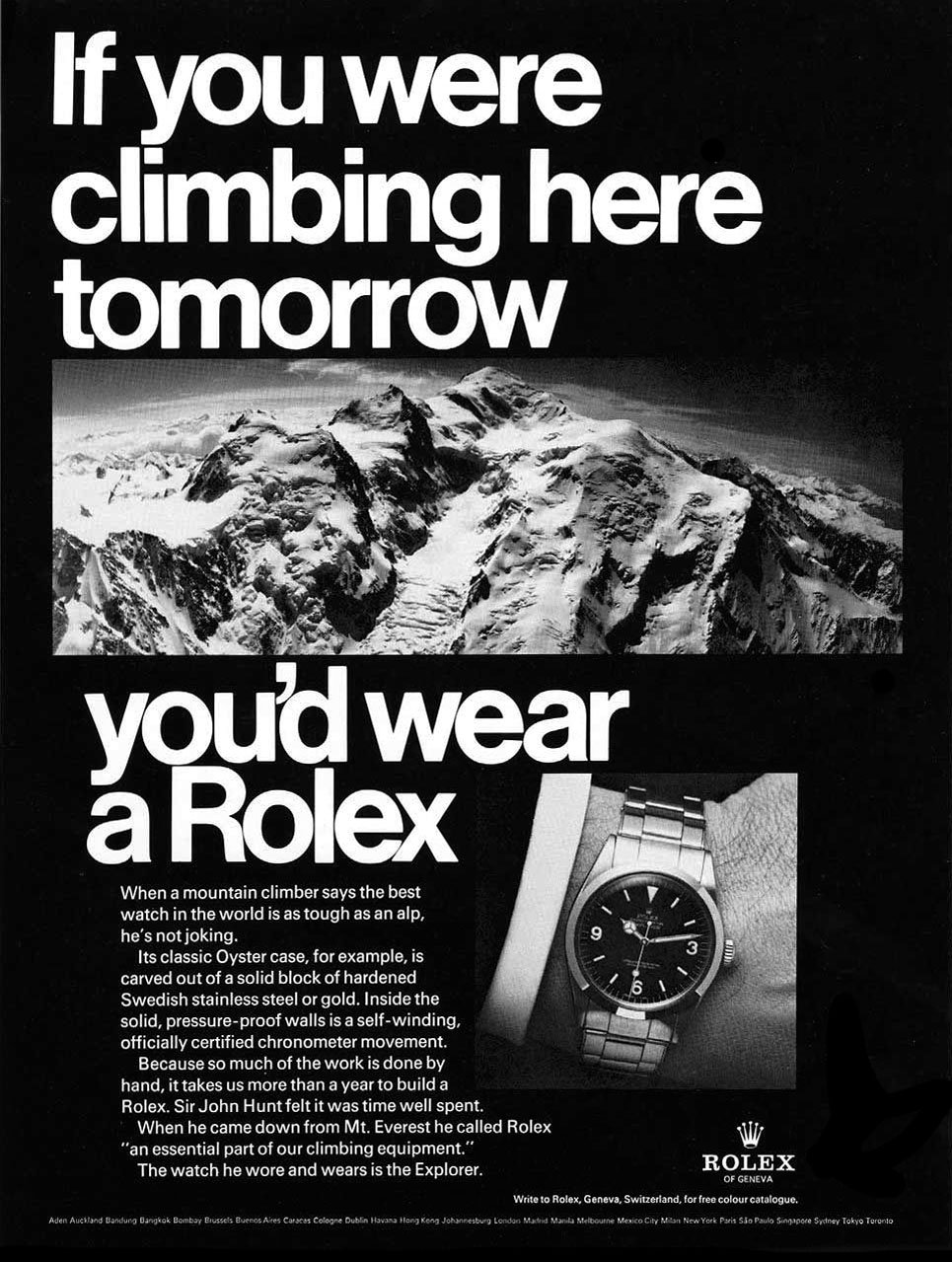
5. The Height of Deception
The last ad we have chosen for the second part in our series on remarkable Rolex ads comes from the iconic ‘You’d wear a Rolex’ ads that were created in the 1960s and 1970s. As mentioned in the first article, the ads feature a very clear grid of text and images placed on a black background. Every single one of the ads featured the message ‘If you were … tomorrow, you’d wear a Rolex.’ set in the iconic Helvetica font. Swiss font designer Max Miedinger created the font, and he named it Helvetica in 1960, which means Swiss in Latin. It’s a beautiful and smart choice Rolex made for the ads.
This ad insinuates that when Hunt came down from Mountain Everest he wore a Rolex Explorer.
In the history of Rolex, one of the most talked-about stories is what watch was the first on Mount Everest. There is tons of info out there on the watches that Sir Edmund Hillary and Tenzing Norgay wore when they reached the top of Mount Everest in 1953 as part of the British Expedition that was lead by Sir John Hunt. Although Rolex also created ads with Hillary and Norgay this specific ad is more interesting as it insinuates that when Hunt came down from Mountain Everest, he wore a Rolex Explorer.
We know this is not true as the Rolex Explorer was introduced after the climbing of Everest and the Rolex watches taken on the expedition were Rolex Oyster Perpetuals. It’s the only flaw in this otherwise great ad. Visually it is a great ad but the wish for Rolex to claim the Everest legacy is so big that they decided to print a false statement. It’s a shame that they did because it really tarnishes a great ad.
Thus concludes our third list of remarkable Rolex ads. Let us know if there are any unusual Rolex ads you remember seeing in the past that you’d like us to look into. Part 4 is currently underway and will be with you soon.
More information about Rolex on their official website.
*Most ads used from these sources can be traced back to Rolex Magazine, a website dedicated to this brand. Others were grabbed via Pinterest. Lead image courtesy of Brittanica.com.

